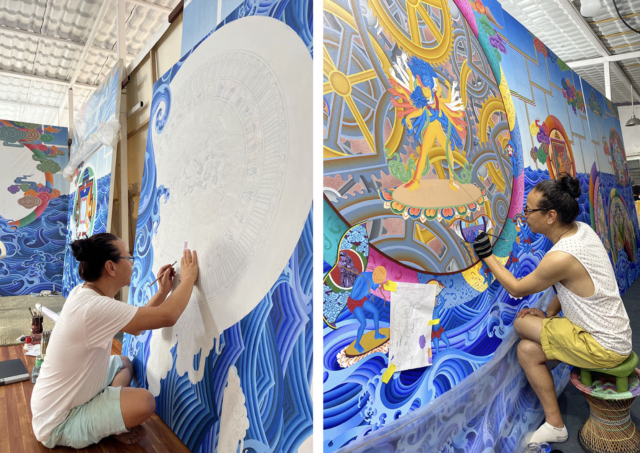
Tenzing Rigdol at work on Biography of a Thought (photo courtesy the Metropolitan Museum of Art)
MANDALAS: MAPPING THE BUDDHIST ART OF TIBET
Metropolitan Museum of Art, Met Fifth Ave.
1000 Fifth Ave. at 82nd St.
Through January 12, $30 (NY, NJ, CT residents pay-what-you-wish)
212-535-7710
www.metmuseum.org
biography of a thought online slideshow
This is the last weekend to see the Met’s “Mandalas: Mapping the Buddhist Art of Tibet,” a stunning collection of mandalas, symbolic geometric diagrams of the universe that relate spiritual stories of unity, balance, and inner harmony, so it is appropriate that the exhibit is in the downstairs octagonal galleries of the Robert Lehman Wing. The works go back as far as a thousand years, ranging from portraits of masters to manuscripts and manuscript covers, from fragmentary leaves of sutras to small statues of bodhisattvas, from glittering crown ornaments to dance robes and stage masks.
Highlights include the “Thousand-Armed Chenresi, a Cosmic Form of the Bodhisattva Avalokiteshvara,” a gilt copper alloy statue with multiple arms and heads; the dizzying “Vajradhatu (Diamond Realm) Mandala,” in which the Buddha Vairochana is surrounded by celestial realms; a Bhutanese skeleton mask placed atop a Tibetan dance costume; and “Chest with Scenes of Tantric Offerings,” populated by gory depictions of animals and skeletons amid hellish violence.
In the center of the exhibit, in the atrium, is Tenzing Rigdol’s Biography of a Thought, an installation with no beginning or end that invites visitors to place themselves in the center, like a buddha in the middle of a thangka. Commissioned specifically for the exhibition, the immersive, colorful work features four walls of murals in addition to a box exploring interdependency and handwoven carpeting with symbolic imagery.
Rigdol, who was born in Kathmandu in 1982, calls it “the journey of a single thought that gathers momentum and produces many thoughts that cluster and form ideas.” Among those ideas are climate change (roiling seas, a lone polar bear), environmental pollution (smokestacks), social injustice (George Floyd), government whistleblowers (a Mount Rushmore–style depiction of Frances Haugen, Chelsea Manning, Edward Snowden, and Julian Assange that resembles a country rock band), terrorism (the Twin Towers), and Western art (Picasso’s Les Demoiselles d’Avignon reimagined as five taras representing the five sensory faculties). Rigdol also puts himself in the work, in a series of figures with a wrapped head, carrying burdens and expressing his ignorance.
In addition, Rigdol incorporates ASL mudras and poetry in Braille that are not translated, part of the artist’s mission to communicate “without belonging to any nation, race, class, group, tribe, club, or creed.”
The Braille poem sums up Rigdol’s vision: “I see the sun / I see cloud / I see river / I see soil / I see the universe / within interdependency.”
[Mark Rifkin is a Brooklyn-born, Manhattan-based writer and editor; you can follow him on Substack here.]